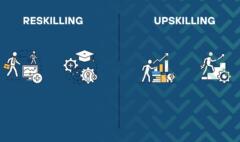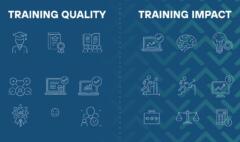Difference between Training Needs Analysis (TNA) and Learning Needs Assessment (LNA)

Difference between Training Needs Analysis (TNA) and Learning Needs Assessment (LNA)
Introduction: Why do we need Training Needs Assessment?
In a world that is changing rapidly, and in front of a job market full of new technologies and renewed skills, randomness in providing training courses is no longer an acceptable option.
Rather, it has become necessary for every training center to begin its steps with a basic question: What is the real need for training?
Here appears the importance of Training Needs Assessment, which ensures that training programs are not provided just “to fill tables,” but address real gaps and enhance the performance of individuals and organizations.
But within this broad concept, we hear two terms that are often confused:
- TNA – Training Needs Analysis
- LNA – Learning Needs Assessment
So what is the difference between them? When do we use each? Are they just two terms for the same idea, or does each have a different purpose and methodology?
This is what we will detail in this article, especially in the context of Saudi training centers seeking to achieve the highest standards of efficiency and quality and to link training to actual and realistic needs.
Definition of TNA (Training Needs Analysis)
What is TNA?
Training Needs Analysis (TNA) is a systematic analysis process aimed at identifying skill and knowledge gaps among employees or individuals that can be filled through training.
Objectives of TNA:
- Know whether training is the appropriate solution to a performance problem.
- Determine the appropriate type of training (skill based, knowledge based, behavioral).
- Identify who needs training, when, how long, and what the content should be.
When is TNA used?
- When there is a decline in performance in a specific job.
- Before preparing an annual training plan.
- When introducing a new system or technology that requires employee training.
- During restructuring of departments or work teams.
Successful outputs of TNA include:
- A list of skill gaps.
- Recommendations for the necessary types of training.
- Precise description of the target group for training.
TNA is considered a practical and direct tool used by training centers and institutions to provide targeted, measurable training that impacts performance.
Definition of LNA (Learning Needs Assessment)
What is LNA?
LNA is a comprehensive assessment that focuses on what individuals need to learn or develop, whether through training or any other learning means (such as coaching, self learning, academic study…).
The main difference?
While TNA focuses on performance in the work context, LNA is broader and includes everything related to individual or group learning and development needs.
Objectives of LNA:
- Discover learners’ interests and professional aspirations.
- Identify barriers hindering learning (like low motivation or lack of resources).
- Propose a variety of learning methods, not just training.
When is LNA used?
- When designing individual or career development plans.
- In environments of continuous learning and long term training.
- To build integrated educational programs, such as institutional academies.
- In cases of personal development for high performing employees.
Outputs of LNA:
- A comprehensive learning map.
- Analysis of suitable learning styles for each individual.
- Linking learning objectives to institutional or personal goals.
LNA is considered a strategic tool used in building a sustainable learning culture, not just temporary training programs.
Fundamental Difference Between TNA and LNA
Despite the superficial similarity in the terms, there are fundamental differences that determine when and how each is used:
| Item | TNA (Training Needs Analysis) | LNA (Learning Needs Assessment) |
| Main Objective | Identify skill gaps to improve performance | Identify what should be learned for personal or professional growth |
| Scope | Usually limited to the work environment | Includes work, self learning, and future learning |
| Focus | Training as a solution to performance issues | Learning as a tool for comprehensive and varied development |
| Approach | Job analysis – tasks – performance | Interviews – surveys – self assessment |
| Outputs | A short or mid term training plan | A long term, multi modal learning plan |
| Target Group | Typically employees with performance gaps | Anyone who wishes to grow or transition professionally |
Conclusion of the discussion:
- TNA is an operational tool to solve performance problems.
- LNA is a strategic tool to support continuous learning.
Types of Needs Covered by Each
To understand the differences more deeply, we must recognize the types of needs each assessment can uncover:
- Training Needs Analysis (TNA):
- Performance needs: related to underperformance or misunderstanding in a specific task.
- Legal/legislative needs: such as occupational safety training or regulatory procedures.
- Institutional needs: based on structural change or expansion of new services.
- Emergency needs: after repeated errors or incidents requiring immediate intervention.
- Learning Needs Assessment (LNA):
- Developmental needs: desire for self development or leadership skills.
- Future professional needs: readiness to move to a higher position or new job.
- Personal educational needs: learning languages, communication skills, advanced digital skills.
- Cultural or value needs: learning related to changing corporate culture or work environment.
Tools and Methods for Implementing TNA
To achieve an accurate Training Needs Analysis (TNA), you must use systematic tools that contribute to obtaining real and applicable information.
Effective tools in TNA:
- One on one interviews with direct managers
Provide insight into skill gaps within the team. - Directed questionnaires
Distributed to employees to assess confidence in their skills versus required tasks. - Job performance analysis
Compare current performance with the ideal expected for each job. - Field observation
Observe the employee during task performance to discover mistakes, repetitions, or slowness. - Analysis of customer complaints or internal evaluation results
Often indicate weakness in certain skills.
Practical example:
In a Saudi training center, TNA was used to identify that a department suffered from weak use of e-learning systems. Result: a short training program was built to upgrade trainers’ technical skills.
Tools and Methods for Implementing LNA
Learning Needs Assessment (LNA) is broader and focuses on learner motivation and self development, so it needs analytical and participatory tools.
Effective tools in LNA:
- Analysis of career development plans
To understand the path the employee is targeting in the future. - Group brainstorming sessions
To discover trainees’ interests and challenges they face. - Self‑assessment questionnaires for skills
Help the employee identify their weaknesses and strengths. - Personal interviews
To uncover psychological or cultural barriers preventing learning. - Future skills maps of the organization
Used to guide employees toward required future skills.
Practical example:
LNA was implemented within a professional academy to design a leadership program for the next generation. Result: a personal learning path was built for each employee including leadership, emotional intelligence, and institutional communication.
When to Use TNA? And When to Use LNA?
Choosing the appropriate tool depends on the objective and context:
| Situation | Appropriate Tool |
| Decline in sales team performance | TNA |
| Launching a project to prepare second-tier leaders | LNA |
| Repeated errors in client reports | TNA |
| Designing an internal learning academy | LNA |
| Assessing readiness of employees for promotions | Both TNA and LNA |
Recommendation: Use TNA in situations related to “performance,” and LNA when the goal is “future capacity development.”
How Using the Wrong Model Affects Training Effectiveness
Using the wrong tool may lead to:
- Inappropriate training: e.g., training employees on skills that do not address the real issue.
- Wasting resources: time, effort, and budget drained without actual return.
- Weak results: the program does not create tangible change in behavior or performance.
- Trainee frustration: because they feel the training does not meet their real need.
- Damage to the training center’s reputation: due to weak program impact.
In short, misjudgment in analysis = failure in planning and implementation.
Practical Applications of Both Concepts in Training Centers
Inside the training center:
- TNA: Identify required courses based on company requests or past outputs.
- LNA: Develop internal learning paths for trainers or administrative staff.
With clients (companies or individuals):
- TNA: Design custom programs for low performance cases.
- LNA: Build leadership programs or develop general skills.
Local example:
A training center in Riyadh used TNA with the customer service sector, and LNA with fresh graduates to determine suitable training specializations.
The Role of Senior Management in Supporting Analysis and Evaluation
Why is management important?
- They provide information and data.
- They grant approvals and budgets.
- They set training priorities.
How to participate effectively:
- Appoint a strategic support committee for needs assessment.
- Define KPIs linked to TNA/LNA results.
- Share analysis results with employees to raise awareness of training needs.
The Relationship Between TNA/LNA and Building Annual Training Plans
- A training plan based only on TNA: more realistic, but short term.
- A plan based only on LNA: developmental in nature, but may neglect urgent priorities.
The best approach?
Integrate outputs from both analyses to build a balanced annual plan including:
- Urgent training to improve performance.
- Sustainable development pathways for employees.
How to Integrate TNA and LNA Results into Training Program Design
Integrated action plan:
- Start with TNA to analyze urgent gaps.
- Integrate LNA results to add long-term development aspects.
- Design content flexibly to serve both needs.
- Segment trainees according to their needs (urgent vs developmental).
- Conduct continuous evaluation to adjust the program based on practical application.
Challenges Facing Implementation of TNA and LNA and How to Overcome Them
| Challenge | Proposed Solution |
| Low employee or management cooperation | Raise awareness of the importance of evaluation and link it to performance |
| Lack of data | Use multiple analysis tools to obtain accurate data |
| Unclear gaps | Involve direct performance managers for job analysis |
| Difficulty applying LNA results | Design flexible, customizable learning pathways |
| Resistance to training based on results | Clarify the direct benefit of each training program |
Conclusion
No Effective Training Without a Clear Real Need
Building an outstanding training program does not start with content design, but with understanding what the trainee really needs. Therefore, using TNA and LNA is not an administrative luxury, but the first step toward effective, impactful, and sustainable training.
Success in training starts with analysis and ends in change.
So do not waste your resources on programs that do not address a problem or align with ambition.
Frequently Asked Questions (FAQs)
- Can TNA and LNA be implemented together?
Yes, it is preferable to combine them to build a comprehensive and balanced training plan. - Is TNA only used in the work environment?
Usually yes, because it focuses on improving job performance, while LNA can be used in any learning context. - How do I know if the analysis result is accurate?
Through using diverse tools, reviewing results with multiple parties, and linking the analysis to actual performance indicators. - Is LNA suitable for individual training?
Definitely, especially for those looking to develop personally or change careers. - What is the ideal period for conducting needs assessment?
At least once annually, with periodic updates based on institutional or market changes.



